Analysis of Fast Food Market: Externalities, Demand and Supply
VerifiedAdded on 2021/02/19
|8
|1331
|29
Report
AI Summary
This report provides an economic analysis of the fast food market, focusing on externalities, demand, and supply dynamics, particularly within the context of the Australian market. It begins by defining externalities and illustrating their impact on the fast food industry, such as the health implications for consumers and environmental concerns. The report discusses government interventions, like the Australia New Zealand Food Authority Act, and the differences between regulated and unregulated markets. The analysis then shifts to the demand for traditional fast food, considering factors like population growth and consumer spending. Recommendations for fast food businesses include menu modifications to include healthier options. The report also examines the rising demand for healthier fast food alternatives and how this impacts price and supply. Finally, a graph illustrates the inverse relationship between price and demand, and the direct relationship between price and supply. The report concludes with references to relevant academic literature.

Price and market
Paraphrase This Document
Need a fresh take? Get an instant paraphrase of this document with our AI Paraphraser
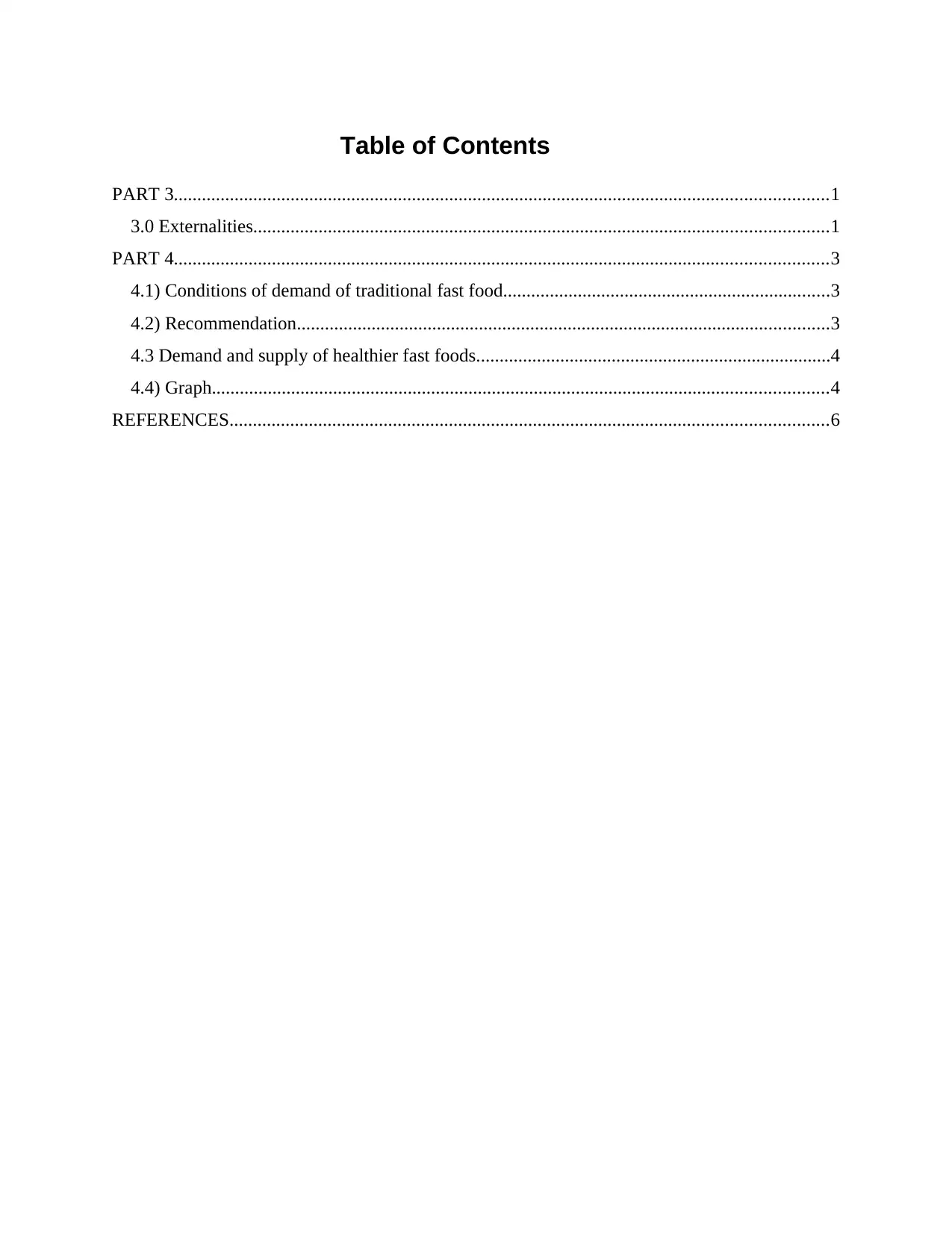
Table of Contents
PART 3............................................................................................................................................1
3.0 Externalities...........................................................................................................................1
PART 4............................................................................................................................................3
4.1) Conditions of demand of traditional fast food......................................................................3
4.2) Recommendation..................................................................................................................3
4.3 Demand and supply of healthier fast foods............................................................................4
4.4) Graph....................................................................................................................................4
REFERENCES................................................................................................................................6
PART 3............................................................................................................................................1
3.0 Externalities...........................................................................................................................1
PART 4............................................................................................................................................3
4.1) Conditions of demand of traditional fast food......................................................................3
4.2) Recommendation..................................................................................................................3
4.3 Demand and supply of healthier fast foods............................................................................4
4.4) Graph....................................................................................................................................4
REFERENCES................................................................................................................................6
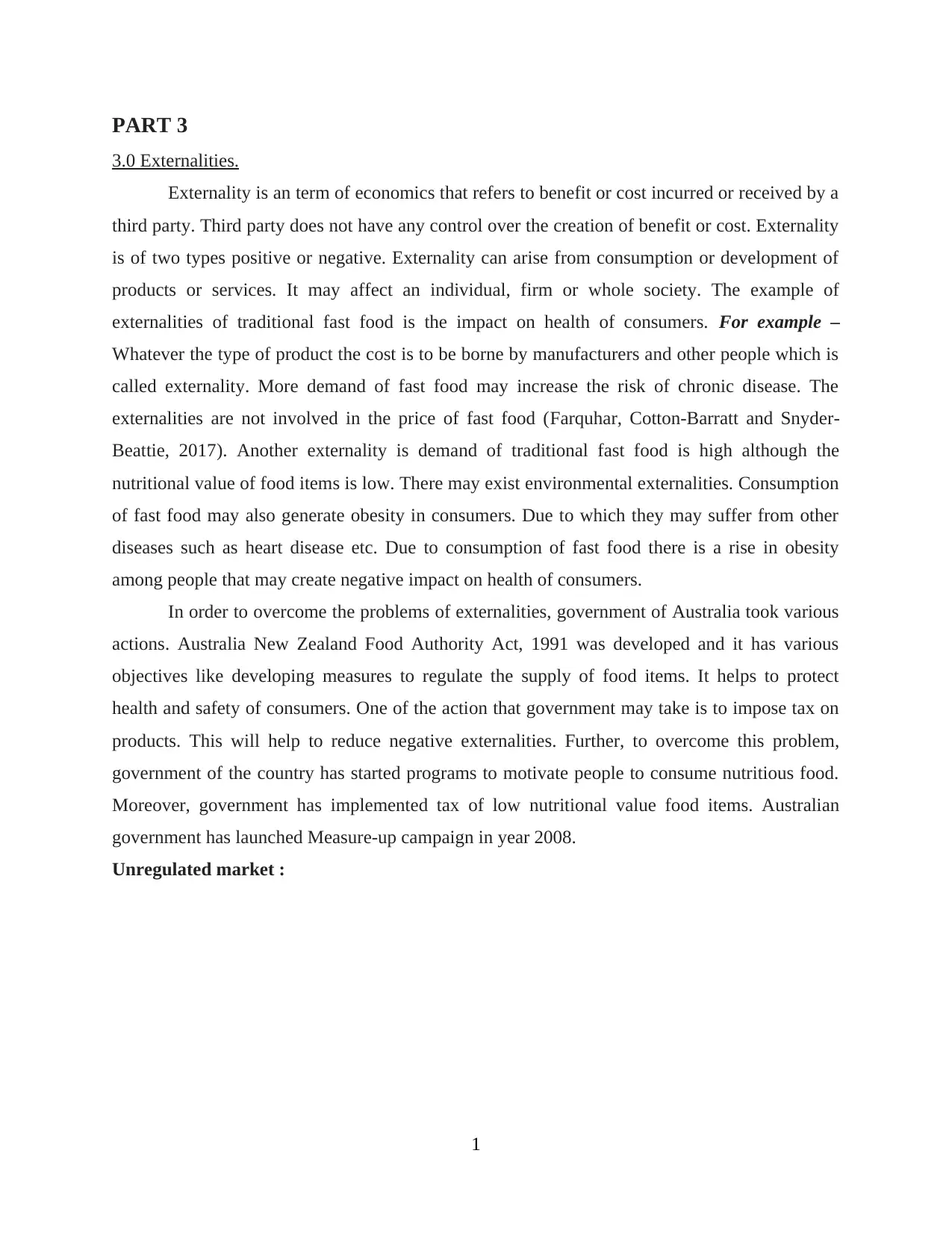
PART 3
3.0 Externalities.
Externality is an term of economics that refers to benefit or cost incurred or received by a
third party. Third party does not have any control over the creation of benefit or cost. Externality
is of two types positive or negative. Externality can arise from consumption or development of
products or services. It may affect an individual, firm or whole society. The example of
externalities of traditional fast food is the impact on health of consumers. For example –
Whatever the type of product the cost is to be borne by manufacturers and other people which is
called externality. More demand of fast food may increase the risk of chronic disease. The
externalities are not involved in the price of fast food (Farquhar, Cotton-Barratt and Snyder-
Beattie, 2017). Another externality is demand of traditional fast food is high although the
nutritional value of food items is low. There may exist environmental externalities. Consumption
of fast food may also generate obesity in consumers. Due to which they may suffer from other
diseases such as heart disease etc. Due to consumption of fast food there is a rise in obesity
among people that may create negative impact on health of consumers.
In order to overcome the problems of externalities, government of Australia took various
actions. Australia New Zealand Food Authority Act, 1991 was developed and it has various
objectives like developing measures to regulate the supply of food items. It helps to protect
health and safety of consumers. One of the action that government may take is to impose tax on
products. This will help to reduce negative externalities. Further, to overcome this problem,
government of the country has started programs to motivate people to consume nutritious food.
Moreover, government has implemented tax of low nutritional value food items. Australian
government has launched Measure-up campaign in year 2008.
Unregulated market :
1
3.0 Externalities.
Externality is an term of economics that refers to benefit or cost incurred or received by a
third party. Third party does not have any control over the creation of benefit or cost. Externality
is of two types positive or negative. Externality can arise from consumption or development of
products or services. It may affect an individual, firm or whole society. The example of
externalities of traditional fast food is the impact on health of consumers. For example –
Whatever the type of product the cost is to be borne by manufacturers and other people which is
called externality. More demand of fast food may increase the risk of chronic disease. The
externalities are not involved in the price of fast food (Farquhar, Cotton-Barratt and Snyder-
Beattie, 2017). Another externality is demand of traditional fast food is high although the
nutritional value of food items is low. There may exist environmental externalities. Consumption
of fast food may also generate obesity in consumers. Due to which they may suffer from other
diseases such as heart disease etc. Due to consumption of fast food there is a rise in obesity
among people that may create negative impact on health of consumers.
In order to overcome the problems of externalities, government of Australia took various
actions. Australia New Zealand Food Authority Act, 1991 was developed and it has various
objectives like developing measures to regulate the supply of food items. It helps to protect
health and safety of consumers. One of the action that government may take is to impose tax on
products. This will help to reduce negative externalities. Further, to overcome this problem,
government of the country has started programs to motivate people to consume nutritious food.
Moreover, government has implemented tax of low nutritional value food items. Australian
government has launched Measure-up campaign in year 2008.
Unregulated market :
1
⊘ This is a preview!⊘
Do you want full access?
Subscribe today to unlock all pages.

Trusted by 1+ million students worldwide
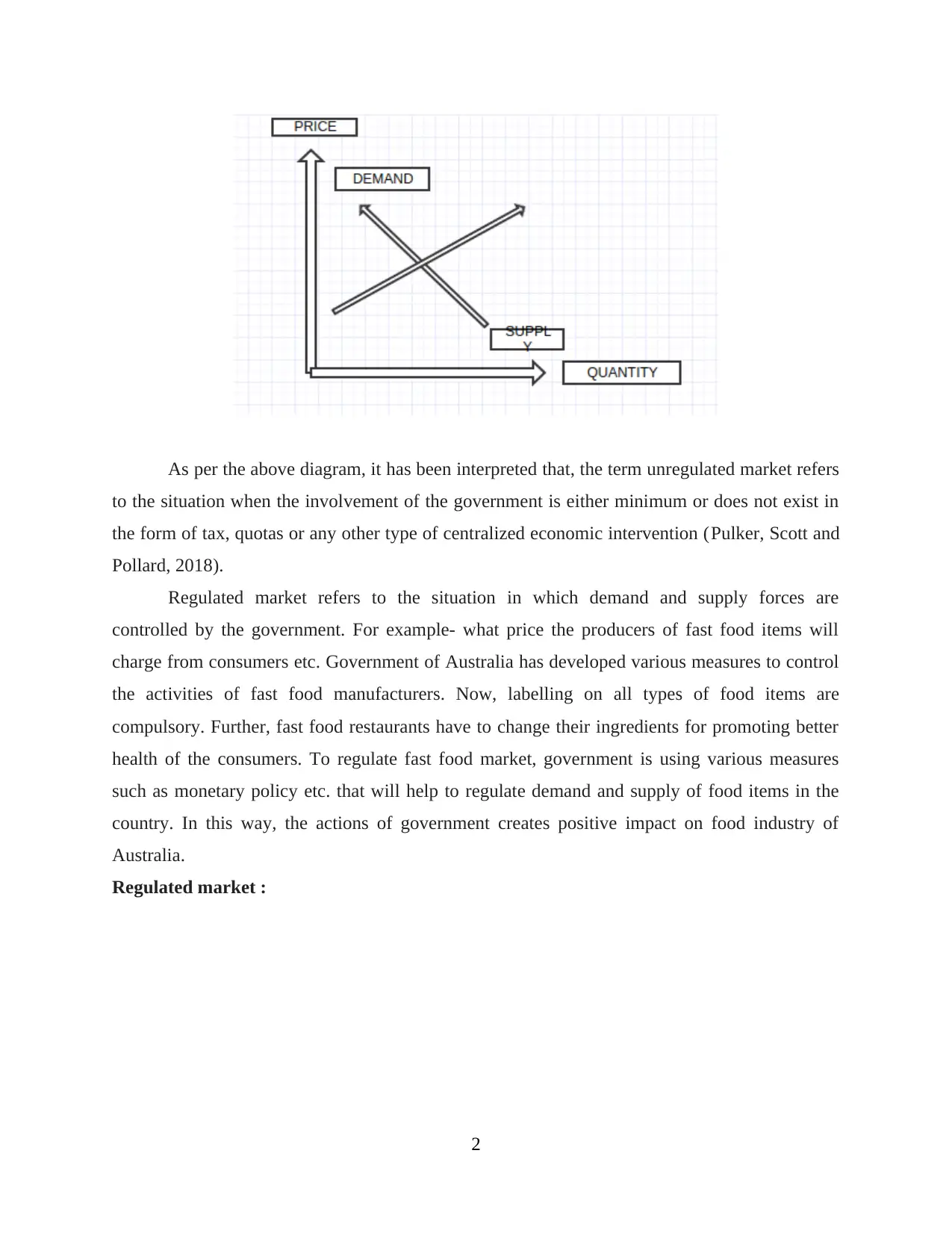
As per the above diagram, it has been interpreted that, the term unregulated market refers
to the situation when the involvement of the government is either minimum or does not exist in
the form of tax, quotas or any other type of centralized economic intervention (Pulker, Scott and
Pollard, 2018).
Regulated market refers to the situation in which demand and supply forces are
controlled by the government. For example- what price the producers of fast food items will
charge from consumers etc. Government of Australia has developed various measures to control
the activities of fast food manufacturers. Now, labelling on all types of food items are
compulsory. Further, fast food restaurants have to change their ingredients for promoting better
health of the consumers. To regulate fast food market, government is using various measures
such as monetary policy etc. that will help to regulate demand and supply of food items in the
country. In this way, the actions of government creates positive impact on food industry of
Australia.
Regulated market :
2
to the situation when the involvement of the government is either minimum or does not exist in
the form of tax, quotas or any other type of centralized economic intervention (Pulker, Scott and
Pollard, 2018).
Regulated market refers to the situation in which demand and supply forces are
controlled by the government. For example- what price the producers of fast food items will
charge from consumers etc. Government of Australia has developed various measures to control
the activities of fast food manufacturers. Now, labelling on all types of food items are
compulsory. Further, fast food restaurants have to change their ingredients for promoting better
health of the consumers. To regulate fast food market, government is using various measures
such as monetary policy etc. that will help to regulate demand and supply of food items in the
country. In this way, the actions of government creates positive impact on food industry of
Australia.
Regulated market :
2
Paraphrase This Document
Need a fresh take? Get an instant paraphrase of this document with our AI Paraphraser
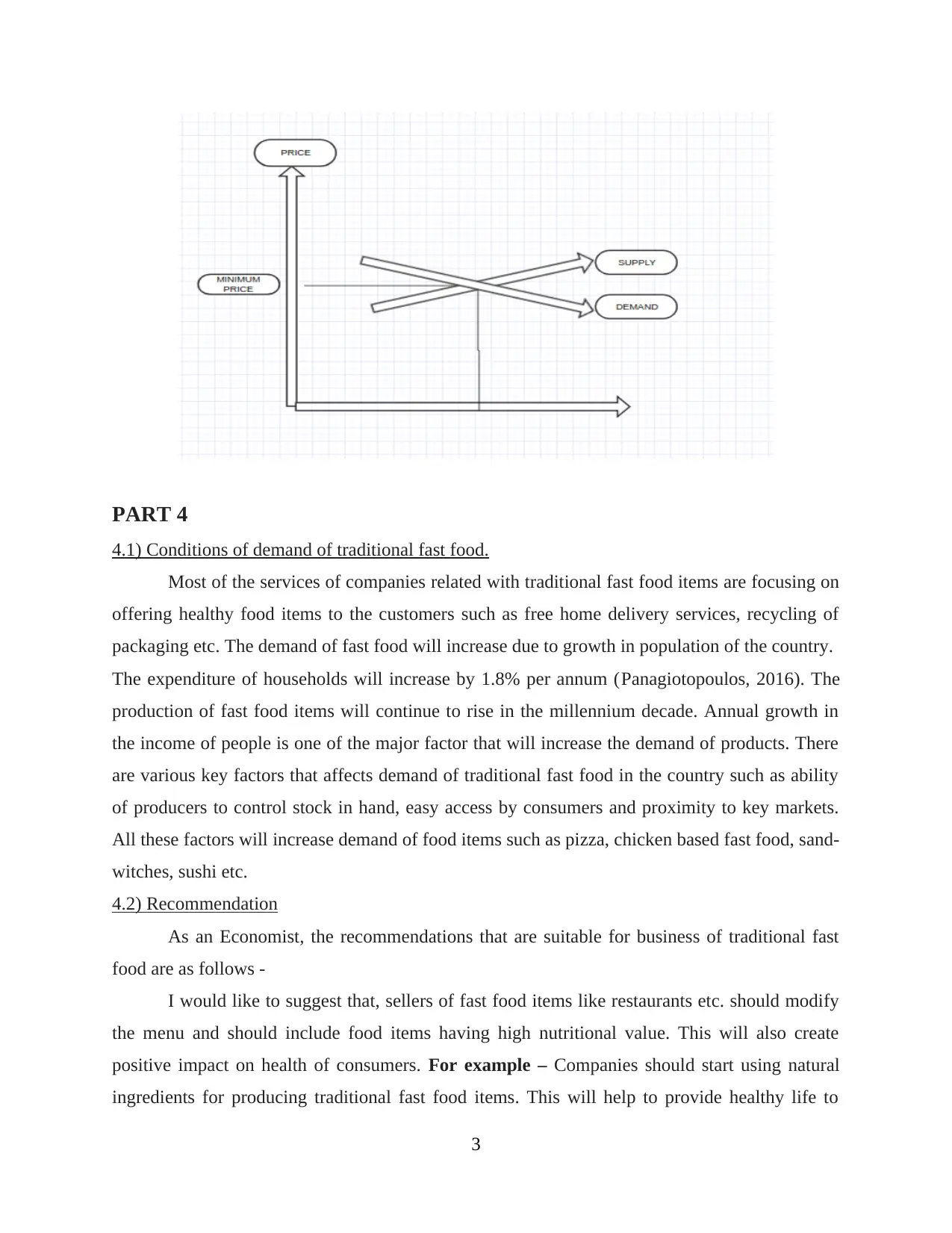
PART 4
4.1) Conditions of demand of traditional fast food.
Most of the services of companies related with traditional fast food items are focusing on
offering healthy food items to the customers such as free home delivery services, recycling of
packaging etc. The demand of fast food will increase due to growth in population of the country.
The expenditure of households will increase by 1.8% per annum (Panagiotopoulos, 2016). The
production of fast food items will continue to rise in the millennium decade. Annual growth in
the income of people is one of the major factor that will increase the demand of products. There
are various key factors that affects demand of traditional fast food in the country such as ability
of producers to control stock in hand, easy access by consumers and proximity to key markets.
All these factors will increase demand of food items such as pizza, chicken based fast food, sand-
witches, sushi etc.
4.2) Recommendation
As an Economist, the recommendations that are suitable for business of traditional fast
food are as follows -
I would like to suggest that, sellers of fast food items like restaurants etc. should modify
the menu and should include food items having high nutritional value. This will also create
positive impact on health of consumers. For example – Companies should start using natural
ingredients for producing traditional fast food items. This will help to provide healthy life to
3
4.1) Conditions of demand of traditional fast food.
Most of the services of companies related with traditional fast food items are focusing on
offering healthy food items to the customers such as free home delivery services, recycling of
packaging etc. The demand of fast food will increase due to growth in population of the country.
The expenditure of households will increase by 1.8% per annum (Panagiotopoulos, 2016). The
production of fast food items will continue to rise in the millennium decade. Annual growth in
the income of people is one of the major factor that will increase the demand of products. There
are various key factors that affects demand of traditional fast food in the country such as ability
of producers to control stock in hand, easy access by consumers and proximity to key markets.
All these factors will increase demand of food items such as pizza, chicken based fast food, sand-
witches, sushi etc.
4.2) Recommendation
As an Economist, the recommendations that are suitable for business of traditional fast
food are as follows -
I would like to suggest that, sellers of fast food items like restaurants etc. should modify
the menu and should include food items having high nutritional value. This will also create
positive impact on health of consumers. For example – Companies should start using natural
ingredients for producing traditional fast food items. This will help to provide healthy life to
3
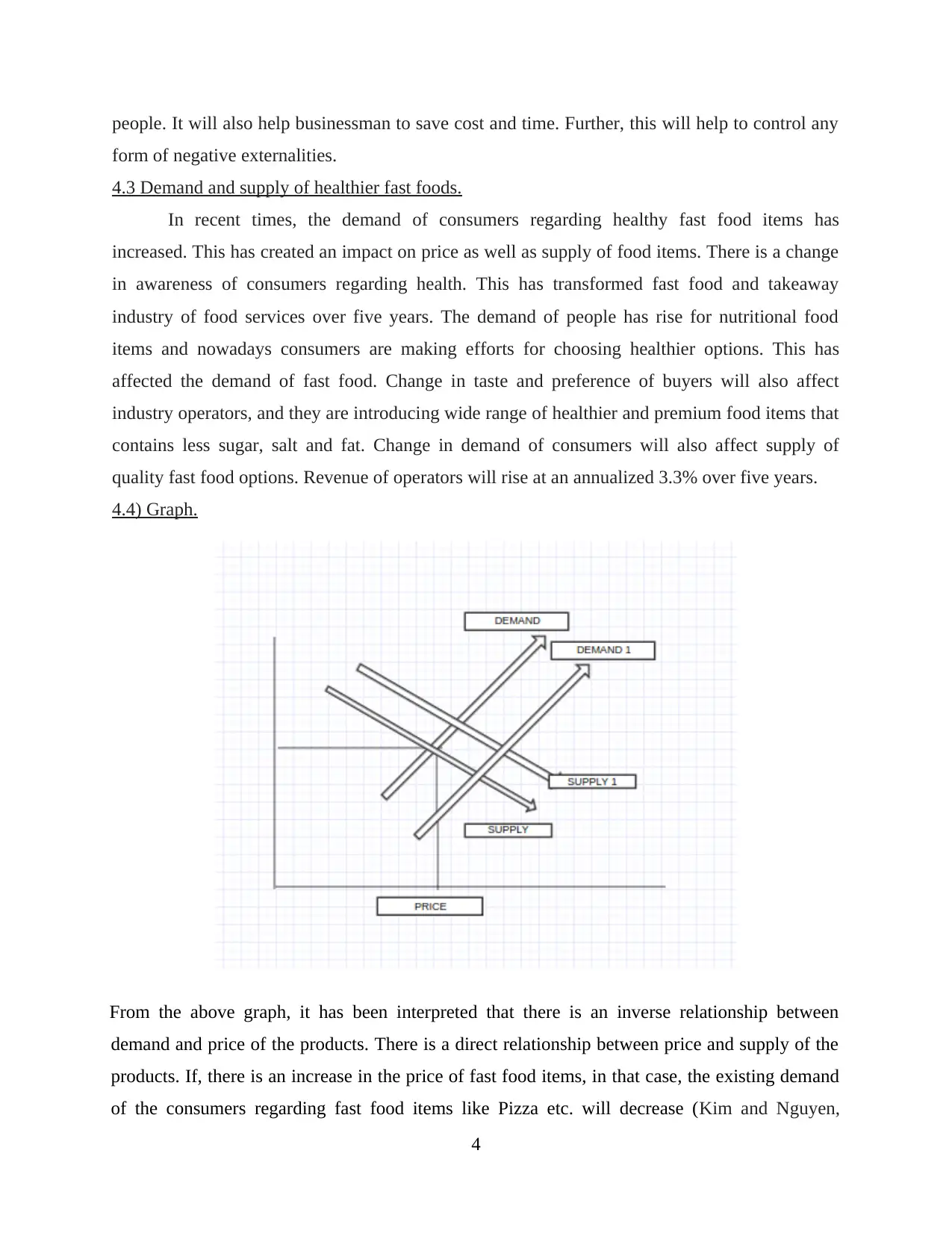
people. It will also help businessman to save cost and time. Further, this will help to control any
form of negative externalities.
4.3 Demand and supply of healthier fast foods.
In recent times, the demand of consumers regarding healthy fast food items has
increased. This has created an impact on price as well as supply of food items. There is a change
in awareness of consumers regarding health. This has transformed fast food and takeaway
industry of food services over five years. The demand of people has rise for nutritional food
items and nowadays consumers are making efforts for choosing healthier options. This has
affected the demand of fast food. Change in taste and preference of buyers will also affect
industry operators, and they are introducing wide range of healthier and premium food items that
contains less sugar, salt and fat. Change in demand of consumers will also affect supply of
quality fast food options. Revenue of operators will rise at an annualized 3.3% over five years.
4.4) Graph.
From the above graph, it has been interpreted that there is an inverse relationship between
demand and price of the products. There is a direct relationship between price and supply of the
products. If, there is an increase in the price of fast food items, in that case, the existing demand
of the consumers regarding fast food items like Pizza etc. will decrease (Kim and Nguyen,
4
form of negative externalities.
4.3 Demand and supply of healthier fast foods.
In recent times, the demand of consumers regarding healthy fast food items has
increased. This has created an impact on price as well as supply of food items. There is a change
in awareness of consumers regarding health. This has transformed fast food and takeaway
industry of food services over five years. The demand of people has rise for nutritional food
items and nowadays consumers are making efforts for choosing healthier options. This has
affected the demand of fast food. Change in taste and preference of buyers will also affect
industry operators, and they are introducing wide range of healthier and premium food items that
contains less sugar, salt and fat. Change in demand of consumers will also affect supply of
quality fast food options. Revenue of operators will rise at an annualized 3.3% over five years.
4.4) Graph.
From the above graph, it has been interpreted that there is an inverse relationship between
demand and price of the products. There is a direct relationship between price and supply of the
products. If, there is an increase in the price of fast food items, in that case, the existing demand
of the consumers regarding fast food items like Pizza etc. will decrease (Kim and Nguyen,
4
⊘ This is a preview!⊘
Do you want full access?
Subscribe today to unlock all pages.

Trusted by 1+ million students worldwide
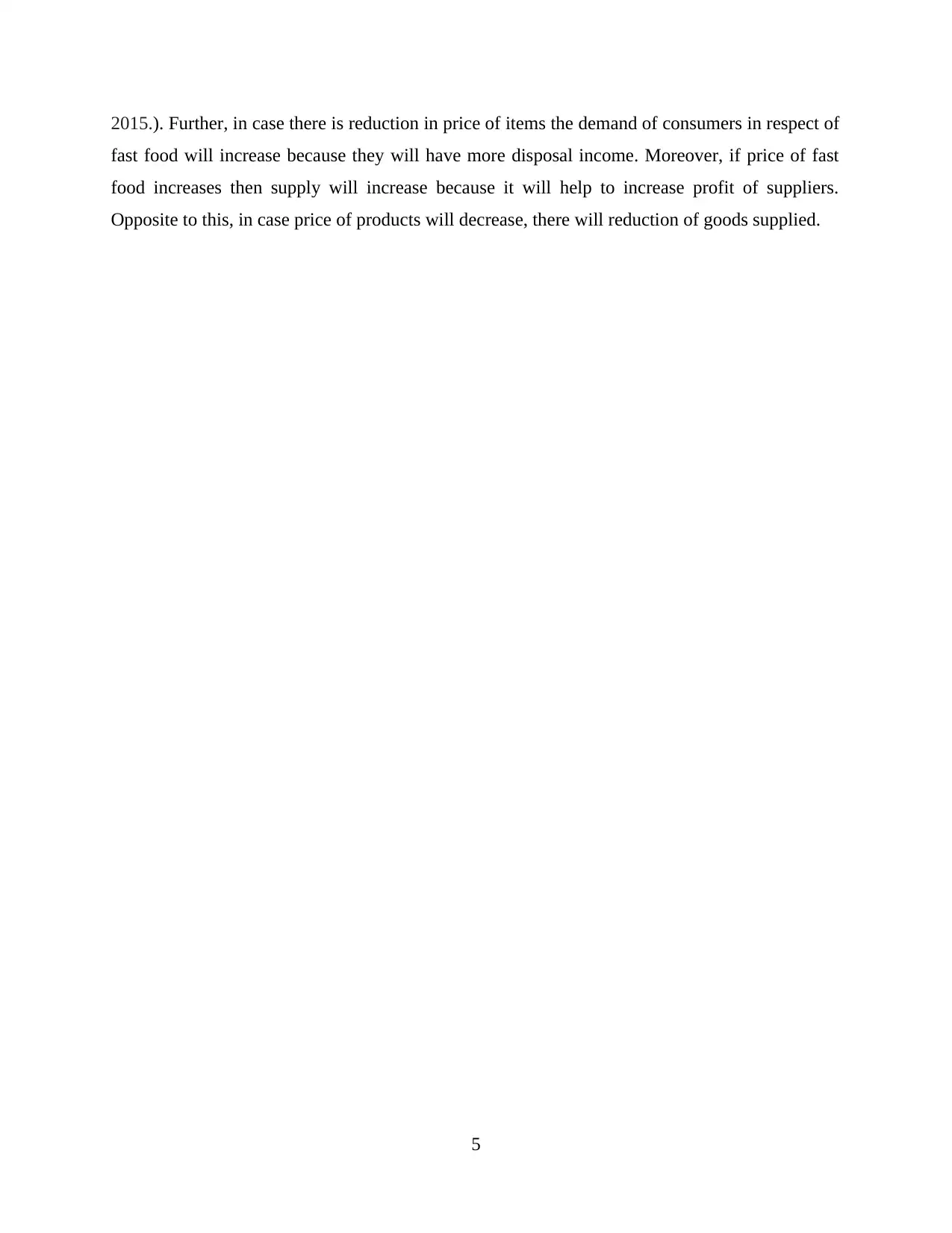
2015.). Further, in case there is reduction in price of items the demand of consumers in respect of
fast food will increase because they will have more disposal income. Moreover, if price of fast
food increases then supply will increase because it will help to increase profit of suppliers.
Opposite to this, in case price of products will decrease, there will reduction of goods supplied.
5
fast food will increase because they will have more disposal income. Moreover, if price of fast
food increases then supply will increase because it will help to increase profit of suppliers.
Opposite to this, in case price of products will decrease, there will reduction of goods supplied.
5
Paraphrase This Document
Need a fresh take? Get an instant paraphrase of this document with our AI Paraphraser
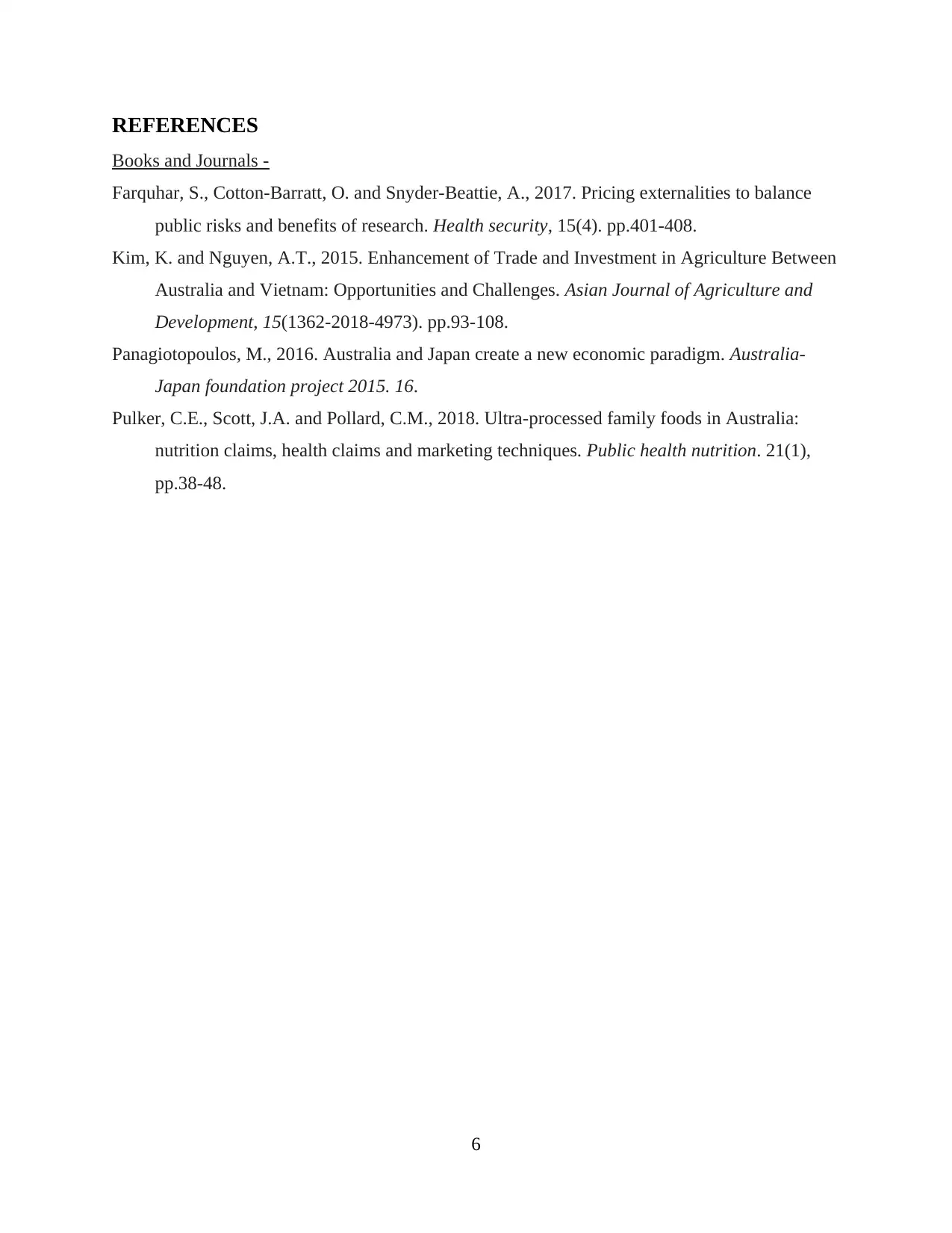
REFERENCES
Books and Journals -
Farquhar, S., Cotton-Barratt, O. and Snyder-Beattie, A., 2017. Pricing externalities to balance
public risks and benefits of research. Health security, 15(4). pp.401-408.
Kim, K. and Nguyen, A.T., 2015. Enhancement of Trade and Investment in Agriculture Between
Australia and Vietnam: Opportunities and Challenges. Asian Journal of Agriculture and
Development, 15(1362-2018-4973). pp.93-108.
Panagiotopoulos, M., 2016. Australia and Japan create a new economic paradigm. Australia-
Japan foundation project 2015. 16.
Pulker, C.E., Scott, J.A. and Pollard, C.M., 2018. Ultra-processed family foods in Australia:
nutrition claims, health claims and marketing techniques. Public health nutrition. 21(1),
pp.38-48.
6
Books and Journals -
Farquhar, S., Cotton-Barratt, O. and Snyder-Beattie, A., 2017. Pricing externalities to balance
public risks and benefits of research. Health security, 15(4). pp.401-408.
Kim, K. and Nguyen, A.T., 2015. Enhancement of Trade and Investment in Agriculture Between
Australia and Vietnam: Opportunities and Challenges. Asian Journal of Agriculture and
Development, 15(1362-2018-4973). pp.93-108.
Panagiotopoulos, M., 2016. Australia and Japan create a new economic paradigm. Australia-
Japan foundation project 2015. 16.
Pulker, C.E., Scott, J.A. and Pollard, C.M., 2018. Ultra-processed family foods in Australia:
nutrition claims, health claims and marketing techniques. Public health nutrition. 21(1),
pp.38-48.
6
1 out of 8
Related Documents
Your All-in-One AI-Powered Toolkit for Academic Success.
+13062052269
info@desklib.com
Available 24*7 on WhatsApp / Email
![[object Object]](/_next/static/media/star-bottom.7253800d.svg)
Unlock your academic potential
Copyright © 2020–2025 A2Z Services. All Rights Reserved. Developed and managed by ZUCOL.





